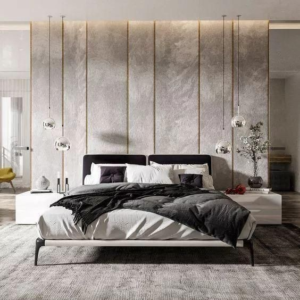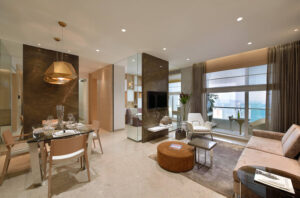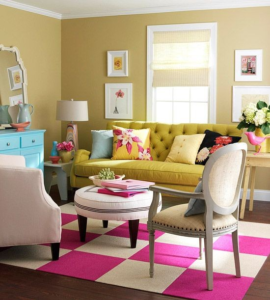Enter a world where artistic expression has no boundaries, where colours and textures dance in perfect harmony, and where your home serves as a blank canvas. Welcome to the enchanted world of interior design, where patterns and textures command attention while telling stories and evoking wonderful moods.
Your living spaces need more than simply furniture and paint to reach their full potential. It calls for the skillful blending of patterns and textures to elevate ordinary spaces into
soul-stirring experiences. We cordially invite you to go with us as we explore the fascinating world of pattern and texture combinations in home design in this post.
Understanding the subtleties of combining patterns and textures enables us to unlock the keys to generating feelings, adding depth and personality, and eventually producing environments that are genuinely unique. For your next interior design project, whether you’re looking for a cozy hideaway, a colorful oasis, or a minimalist haven, we’ve collected insightful information and inspirational images.
Our passion at We Works Interiors is the perfect blending of design and utility. Using our skills, we create environments that reflect your distinct preferences and style while giving life to your concept. Join us as we explore the transforming potential of patterns and textures, equipping you to create enthralling living spaces.

Understanding Patterns
In interior design, patterns are essential for establishing the overall aesthetic and creating visual appeal. It’s critical to take patterns’ scale, style, and colour scheme into account while dealing with them. Smaller patterns can convey a sense of delicacy and complexity, whilst larger patterns can make a dramatic statement and grab attention. Combining patterns with different scales might result in a harmonious and visually balanced design. In addition, take into account how the patterns, whether geometric, floral, or abstract, will fit with the intended ambiance and design of the room. Coordination of colours is yet another important aspect. Combining patterns in colour schemes that are complementary or comparable can produce a unified and attractive visual impact.
Experimenting with Textures
Textures are a great way to give a space depth and tactile interest. Surfaces that are smooth, rough, shiny, or matte can inspire various feelings and add to the ambiance. Consider the type of material being utilised, such as wood, metal, fabric, or stone, when choosing textures. Combining different materials can result in interesting contrasts because each material has an own texture. For example, juxtaposing a soft velvet sofa with a rough, natural stone wall might be eye-catching. Layering textures can also improve a space’s visual richness. To create a visually engaging and attractive space, mix a variety of
materials, like silk, linen, and wool, with diverse finishes, such as brushed metal or lacquered wood.

Harmonizing Patterns and Textures
The next step is to skillfully combine patterns and textures when you have a firm understanding of each one on its own. Choose a focal point or anchor item that features the primary pattern or texture you want to emphasize as your starting point. This might be a piece of distinctive furniture, a textured area rug, or wallpaper with a bold pattern. From there, develop your design around this anchor by introducing complementary patterns and textures. To achieve a unified and well-balanced composition, take into account the scale, hues, and materials of each element.
To create visual appeal, aim for a combination of complementing and contrasting patterns and textures. For example, pair a bold geometric patterned pillow with a subtle striped rug or a textured accent wall with a sleek, monochromatic furniture piece. This interplay of contrasting elements adds depth and complexity to the space.
Practical Tips and Inspirations
To help you craft your pattern and texture combinations effectively, here are some practical tips and inspirational ideas:
- Start small: If you’re new to combining patterns and textures, begin with smaller elements like throw pillows, curtains, or decorative accents. This allows you to experiment and refine your choices without overwhelming the space.
- Balance is key: Strive for a balance between bold and subtle, busy and calm, and rough and smooth. Too much of one element can create visual chaos, while too little
can result in a dull design. Play with proportions until you achieve a harmonious balance.
- Use neutral backdrops: When working with intricate patterns and bold textures, consider using neutral tones for larger surfaces like walls and floors. This creates a visually calming backdrop that allows the patterns and textures to shine.
- Mix and match styles: Don’t be afraid to mix different design styles. Combining vintage and modern elements, for instance, can create a visually stimulating and eclectic space.
- Take inspiration from nature: Nature offers an abundance of patterns and textures. Look to the organic world for inspiration, incorporating elements like leaf motifs, stone textures, or floral patterns to infuse a sense of tranquility and harmony.

Wrapping Up
Understanding of scale, color, and material composition is necessary for creating pattern and texture combinations in interior design. You may make a room into an attractive and interesting atmosphere by deftly fusing various patterns and textures. We Works Interiors is an expert in designing distinctive, aesthetically pleasing interiors that capture your individual tastes and sense of style. Our team of skilled designers is ready to help you realize your idea, whether you’re trying to construct a relaxing retreat or a buzzing gathering area. Make an appointment with us right away for a consultation and allow us to turn your room into a work of art.



